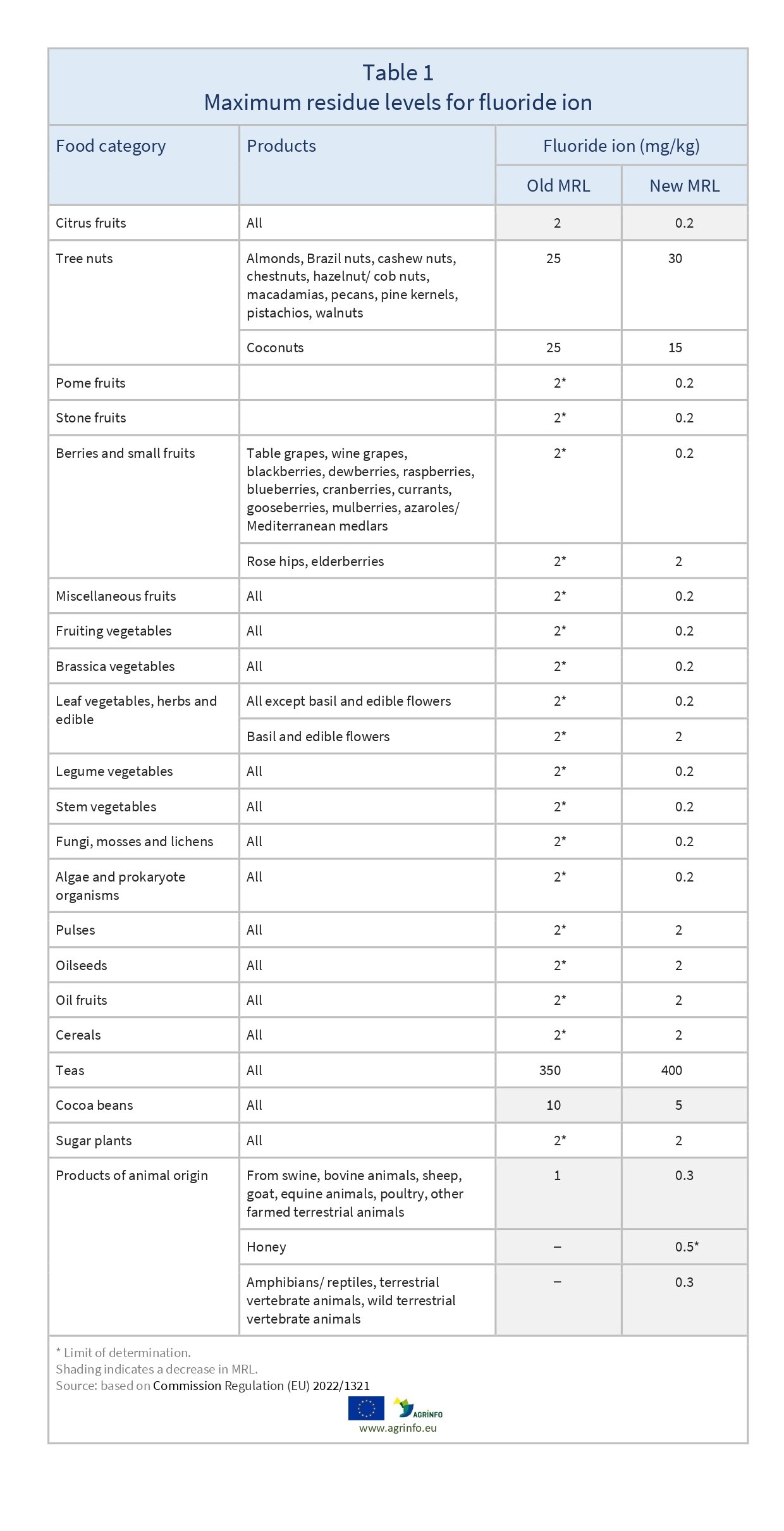Maximum residue levels for fluoride ion
- Pesticide MRLs
Summary
Commission Regulation 2022/1321, published on 25 July, establishes fluoride ion MRLs on a wide range of products – fruits, vegetables, fungi, algae, pulses, oilseeds, oil fruits, cereals, teas, cocoa beans, sugar plants and products of animal origin – that will apply from February 2023.
EU publishes Regulation establishing fluoride ion MRLs for a wide range of products from February 2023, with potential implications for fruits and vegetables
Commission Regulation (EU) 2022/1321 of 25 July 2022 amending Annexes II and III to Regulation (EC) No 396/2005 of the European Parliament and of the Council as regards maximum residue levels for fluoride ion, oxyfluorfen, pyroxsulam, quinmerac and sulfuryl fluoride in or on certain products
Update
Commission Regulation 2022/1321, published on 25 July, establishes fluoride ion MRLs on a wide range of products – fruits, vegetables, fungi, algae, pulses, oilseeds, oil fruits, cereals, teas, cocoa beans, sugar plants and products of animal origin – that will apply from February 2023.
Impacted Products
citrus fruits, almonds, Brazil nuts, cashew nuts, chestnuts, hazelnut/cob nuts, macadamias, pecans, pine kernels, pistachios, walnuts, coconuts, pome fruits, stone fruits, berries and small fruits, miscellaneous fruits, fruiting vegetables, brassica vegetables, legume vegetables, stem vegetables, fungi, mosses and lichens, algae and prokaryotes, pulses, oilseeds, oil fruits, cereals, teas, cocoa beans, sugar plants, products of animal origin
What is changing?
The changes to MRLs are summarised in Table 1.
Why?
Following an evaluation of existing MRLs, EFSA (2021) concluded that insufficient information was available to complete the assessment for fluoride ion. Taking into account additional monitoring data provided by food business operators, the Commission established new MRLs at which there is no risk for consumers.
Timeline
New MRLs will apply from 21 February 2023. Where products are exported in compliance with the old MRLs before 21 February 2023, these products may stay on the market after this date, even where not compliant with new MRLs.
Recommended Actions
Suppliers of all fruits and vegetables should check the use of fluoride ion on these products to verify compliance with established MRLs.
Background
MRLs are set in accordance with the rules set out in Regulation 396/2005. For information on current MRLs for other substances, please consult the EU Pesticide Residues database.
Resources
EFSA (2021) Review of the existing maximum residue levels for sulfuryl fluoride according to Article 12 of Regulation (EC) No 396/2005. EFSA Journal, 19(1): 6390.
Sources
Commission Regulation (EU) 2022/1321
Tables & Figures
 .
.
Disclaimer: Under no circumstances shall COLEAD be liable for any loss, damage, liability or expense incurred or suffered that is claimed to have resulted from the use of information available on this website or any link to external sites. The use of the website is at the user’s sole risk and responsibility. This information platform was created and maintained with the financial support of the European Union. Its contents do not, however, reflect the views of the European Union.
